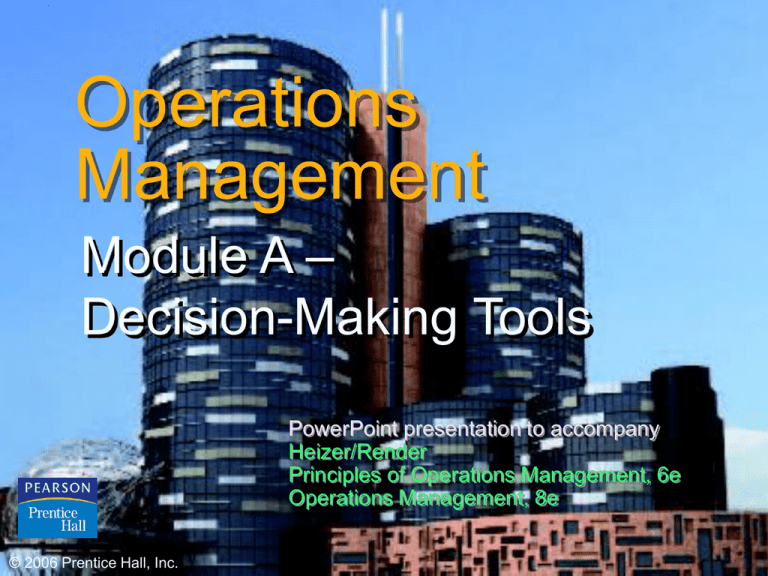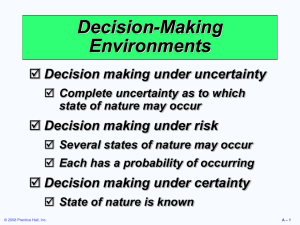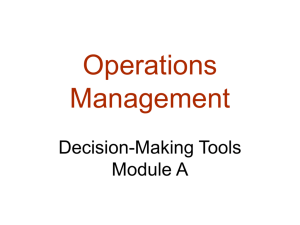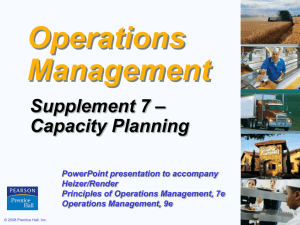Decision-Making Tools
advertisement

Operations Management Module A – Decision-Making Tools PowerPoint presentation to accompany Heizer/Render Principles of Operations Management, 6e Operations Management, 8e © 2006 Prentice Hall, Inc. Hall, Inc. © 2006 Prentice A–1 Outline The Decision Process in Operations Fundamentals of Decision Making Decision Tables © 2006 Prentice Hall, Inc. A–2 Outline – Continued Types of Decision-Making Environments Decision Making Under Uncertainty Decision Making Under Risk Decision Making Under Certainty Expected Value of Perfect Information (EVPI) © 2006 Prentice Hall, Inc. A–3 Outline – Continued Decision Trees A More Complex Decision Tree Using Decision Trees in Ethical Decision Making © 2006 Prentice Hall, Inc. A–4 Learning Objectives When you complete this module, you should be able to: Identify or Define: Decision trees and decision tables Highest monetary value Expected value of perfect information Sequential decisions © 2006 Prentice Hall, Inc. A–5 Learning Objectives When you complete this chapter, you should be able to: Describe or Explain: Decision making under risk Decision making under uncertainty Decision making under certainty © 2006 Prentice Hall, Inc. A–6 The Decision Process in Operations 1. Clearly define the problems and the factors that influence it 2. Develop specific and measurable objectives 3. Develop a model 4. Evaluate each alternative solution 5. Select the best alternative 6. Implement the decision and set a timetable for completion © 2006 Prentice Hall, Inc. A–7 Fundamentals of Decision Making 1. Terms: a. Alternative—a course of action or strategy that may be chosen by the decision maker b. State of nature—an occurrence or a situation over which the decision maker has little or no control © 2006 Prentice Hall, Inc. A–8 Fundamentals of Decision Making 2. Symbols used in a decision tree: a. —decision node from which one of several alternatives may be selected b. —a state-of-nature node out of which one state of nature will occur © 2006 Prentice Hall, Inc. A–9 Decision Tree Example A decision node A state of nature node Favorable market Unfavorable market Construct small plant Favorable market Unfavorable market Figure A.1 © 2006 Prentice Hall, Inc. A – 10 Decision Table Example Alternatives Construct large plant Construct small plant Do nothing State of Nature Favorable Market Unfavorable Market $200,000 –$180,000 $100,000 –$ 20,000 $ 0 $ 0 Table A.1 © 2006 Prentice Hall, Inc. A – 11 Decision-Making Environments Decision making under uncertainty Complete uncertainty as to which state of nature may occur Decision making under risk Several states of nature may occur Each has a probability of occurring Decision making under certainty State of nature is known © 2006 Prentice Hall, Inc. A – 12 Uncertainty 1. Maximax Find the alternative that maximizes the maximum outcome for every alternative Pick the outcome with the maximum number Highest possible gain © 2006 Prentice Hall, Inc. A – 13 Uncertainty 2. Maximin Find the alternative that maximizes the minimum outcome for every alternative Pick the outcome with the minimum number Least possible loss © 2006 Prentice Hall, Inc. A – 14 Uncertainty 3. Equally likely Find the alternative with the highest average outcome Pick the outcome with the maximum number Assumes each state of nature is equally likely to occur © 2006 Prentice Hall, Inc. A – 15 Uncertainty Example States of Nature Alternatives Favorable Market Unfavorable Market Construct large plant $200,000 -$180,000 Construct small plant $100,000 $0 Do nothing Maximum in Row Minimum in Row Row Average $200,000 -$180,000 $10,000 -$20,000 $100,000 -$20,000 $40,000 $0 $0 $0 $0 Maximax Maximin Equally likely 1. Maximax choice is to construct a large plant 2. Maximin choice is to do nothing 3. Equally likely choice is to construct a small plant © 2006 Prentice Hall, Inc. A – 16 Risk Each possible state of nature has an assumed probability States of nature are mutually exclusive Probabilities must sum to 1 Determine the expected monetary value (EMV) for each alternative © 2006 Prentice Hall, Inc. A – 17 Expected Monetary Value EMV (Alternative i) = (Payoff of 1st state of nature) x (Probability of 1st state of nature) + (Payoff of 2nd state of nature) x (Probability of 2nd state of nature) +…+ (Payoff of last state of nature) x (Probability of last state of nature) © 2006 Prentice Hall, Inc. A – 18 EMV Example Table A.3 States of Nature Favorable Market Unfavorable Market Construct large plant (A1) $200,000 -$180,000 Construct small plant (A2) $100,000 -$20,000 Do nothing (A3) $0 $0 Probabilities .50 .50 Alternatives 1. EMV(A1) = (.5)($200,000) + (.5)(-$180,000) = $10,000 2. EMV(A2) = (.5)($100,000) + (.5)(-$20,000) = $40,000 3. EMV(A3) = (.5)($0) + (.5)($0) = $0 © 2006 Prentice Hall, Inc. A – 19 EMV Example Table A.3 States of Nature Favorable Market Unfavorable Market Construct large plant (A1) $200,000 -$180,000 Construct small plant (A2) $100,000 -$20,000 Do nothing (A3) $0 $0 Probabilities .50 .50 Alternatives 1. EMV(A1) = (.5)($200,000) + (.5)(-$180,000) = $10,000 2. EMV(A2) = (.5)($100,000) + (.5)(-$20,000) = $40,000 3. EMV(A3) = (.5)($0) + (.5)($0) = $0 Best Option © 2006 Prentice Hall, Inc. A – 20 Certainty Is the cost of perfect information worth it? Determine the expected value of perfect information (EVPI) © 2006 Prentice Hall, Inc. A – 21 Expected Value of Perfect Information EVPI is the difference between the payoff under certainty and the payoff under risk Expected value Maximum EVPI = under certainty – EMV Expected value . (Best outcome or consequence for 1st under certainty = state of nature) x (Probability of 1st state of nature) + Best outcome for 2nd state of nature) x (Probability of 2nd state of nature) + … + Best outcome for last state of nature) x (Probability of last state of nature) © 2006 Prentice Hall, Inc. A – 22 EVPI Example 1. The best outcome for the state of nature “favorable market” is “build a large facility” with a payoff of $200,000. The best outcome for “unfavorable” is “do nothing” with a payoff of $0. Expected value under certainty = ($200,000)(.50) + ($0)(.50) = $100,000 © 2006 Prentice Hall, Inc. A – 23 EVPI Example 2. The maximum EMV is $40,000, which is the expected outcome without perfect information. Thus: Expected value Maximum EVPI = under certainty – EMV = $100,000 – $40,000 = $60,000 The most the company should pay for perfect information is $60,000 © 2006 Prentice Hall, Inc. A – 24 Decision Trees Information in decision tables can be displayed as decision trees A decision tree is a graphic display of the decision process that indicates decision alternatives, states of nature and their respective probabilities, and payoffs for each combination of decision alternative and state of nature Appropriate for showing sequential decisions © 2006 Prentice Hall, Inc. A – 25 Decision Trees © 2006 Prentice Hall, Inc. A – 26 Decision Trees 1. Define the problem 2. Structure or draw the decision tree 3. Assign probabilities to the states of nature 4. Estimate payoffs for each possible combination of decision alternatives and states of nature 5. Solve the problem by working backward through the tree computing the EMV for each state-of-nature node © 2006 Prentice Hall, Inc. A – 27 Decision Tree Example EMV for node 1 = $10,000 = (.5)($200,000) + (.5)(-$180,000) Payoffs Favorable market (.5) 1 Unfavorable market (.5) Favorable market (.5) Construct small plant 2 EMV for node 2 = $40,000 Figure A.2 © 2006 Prentice Hall, Inc. Unfavorable market (.5) $200,000 -$180,000 $100,000 -$20,000 = (.5)($100,000) + (.5)(-$20,000) $0 A – 28 Complex Decision Tree Example Figure A.3 © 2006 Prentice Hall, Inc. A – 29 Complex Example 1. Given favorable survey results EMV(2) = (.78)($190,000) + (.22)(-$190,000) = $106,400 EMV(3) = (.78)($90,000) + (.22)(-$30,000) = $63,600 The EMV for no plant = -$10,000 so, if the survey results are favorable, build the large plant © 2006 Prentice Hall, Inc. A – 30 Complex Example 2. Given negative survey results EMV(4) = (.27)($190,000) + (.73)(-$190,000) = -$87,400 EMV(5) = (.27)($90,000) + (.73)(-$30,000) = $2,400 The EMV for no plant = -$10,000 so, if the survey results are negative, build the small plant © 2006 Prentice Hall, Inc. A – 31 Complex Example 3. Compute the expected value of the market survey EMV(1) = (.45)($106,400) + (.55)($2,400) = $49,200 4. If the market survey is not conducted EMV(6) = (.5)($200,000) + (.5)(-$180,000) = $10,000 EMV(7) = (.5)($100,000) + (.5)(-$20,000) = $40,000 The EMV for no plant = $0 so, given no survey, build the small plant © 2006 Prentice Hall, Inc. A – 32 Decision Trees in Ethical Decision Making Maximize shareholder value and behave ethically Technique can be applied to any action a company contemplates © 2006 Prentice Hall, Inc. A – 33 Decision Trees in Ethical Decision Making Yes Does action maximize company returns? Yes Is action legal? No No Figure A.4 © 2006 Prentice Hall, Inc. Is it ethical? (Weigh the affect on employees, customers, suppliers, community against shareholder benefit) Is it ethical not to take action? (Weigh the harm to shareholders vs. the benefits to other stakeholders) Yes Do it No Don’t do it Yes Don’t do it No Do it, but notify appropriate parties Don’t do it A – 34







